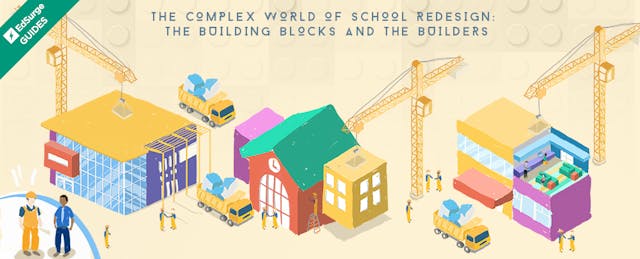There are many building blocks that make up a school. The schedule, budget, infrastructure, school culture and the learning environment represent just a handful. Each element has a tremendous impact on the learning experience for students, staff and families. These blocks can be organized and reorganized in any number of combinations. The way they are put together defines the model of a school.
All over the country, schools regularly experiment with rearranging, reshaping or redesigning these pieces to make school more engaging and personal for students and teachers. These experiments range from a small pilot in one classroom to large scale systemic transformation at the district or even state level and everything in between. Sometimes, a small pilot in one classroom can spark change across an entire region.
Across the country, we see examples of these experiments, big and small, that inspire us to think about what’s possible in schools.
But rethinking schools is hard; changing one building block can shift the entire structure, and always poses challenges. Sometimes a school manages these challenges on its own, but in many cases, a school seeks out experts in a specific area that can help pave the way for change. Experts can come in many forms. Sometimes an expert is a teacher or administrator from another district, and other times an expert is a consultant or organization that specializes in school redesign.
In this guide, we hope to give you a glimpse of what it can look like when a school changes its model. We will share stories from the Great Prairie Area Education Agency, which redesigned two of its classrooms in Iowa; from Hybrid High, which redesigned its entire model in 2013; from a group of ten Oakland schools that redesigned their model together; and from two schools (E.L. Haynes Public Charter School and Wheatley Education Campus) that sparked citywide school redesign across Washington D.C. We will also identify the building blocks that are involved and give you an inside look at the experts who are helping schools along the way.
Thanks to the support of the Bill & Melinda Gates Foundation, we are able to make this report freely available to all. Many thanks also to the five organizations who shared their stories with us: 2Revolutions, CA Group, Education Elements, Mastery Design Collaborative and Transcend Education.
—Marisa Kaplan, Guide Editor
Framework for Categorizing Service Providers
We have developed a framework to help categorize service providers that are helping schools and districts redesign their models. The framework includes a set of essential questions that educators and administrators are asking as they go through the process of redesign, as well as a collection of elements, or building blocks, that schools and districts are commonly looking to transform. Here is our framework and a guide to how we define each of the elements that make up a school's model.
View full-sized image View full-sized image


Stories of Change
As schools and districts explore the questions in our framework, many are taking risks and experimenting with making changes to their school models in order create new ones that better support students and teachers. These changes can be big or small, impacting an entire district or one classroom at a time. Here are four stories of change at varied scales. These stories highlight a small scale pilot that sparked change across a district, a school model redesign, a district-wide redesign and a citywide systemic transformation.
Stories of Service Providers that Have Helped Redesign Schools
Some schools and districts manage school redesign on their own, leveraging the expertise of existing staff members. In many cases however, school and district leaders decide that they need outside support from experts in school transformation. These experts can be companies, nonprofit organizations, individual consultants, and in some cases, schools themselves that codify what has worked for them and offer direct support to others. We have identified five unique and well-known organizations supporting schools and districts in bringing about change and we are sharing their stories to give educators and administrators an inside look at the type of services some organizations provide in order to support the process of school redesign.


